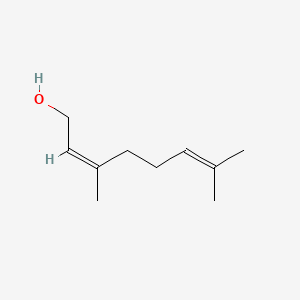| Authors | Title | Published | Journal | PubMed Link |
|---|---|---|---|---|
| Báez D et al. | Floral scent composition of Plumeria tuberculata analyzed by HS-SPME. | 2012 | Nat Prod Commun | pmid:22428259 |
| Subongkot T et al. | Ultradeformable liposomes with terpenes for delivery of hydrophilic compound. | 2012 | J Liposome Res | pmid:22663352 |
| Sacks GL et al. | Sensory threshold of 1,1,6-trimethyl-1,2-dihydronaphthalene (TDN) and concentrations in young Riesling and non-Riesling wines. | 2012 | J. Agric. Food Chem. | pmid:22397689 |
| Singh D et al. | Antimicrobial activity of some promising plant oils, molecules and formulations. | 2012 | Indian J. Exp. Biol. | pmid:23214265 |
| Juega M et al. | Influence of yeast mannoproteins in the aroma improvement of white wines. | 2012 | J. Food Sci. | pmid:22860598 |
| Lüddeke F et al. | Geraniol and geranial dehydrogenases induced in anaerobic monoterpene degradation by Castellaniella defragrans. | 2012 | Appl. Environ. Microbiol. | pmid:22286981 |
| Cordes J et al. | Total syntheses of angelicoin A, hericenone J, and hericenol A via migratory prenyl- and geranylation-aromatization sequences. | 2012 | J. Org. Chem. | pmid:22106838 |
| Hassan M et al. | Monoterpene alcohol metabolism: identification, purification, and characterization of two geraniol dehydrogenase isoenzymes from Polygonum minus leaves. | 2012 | Biosci. Biotechnol. Biochem. | pmid:22878188 |
| Annadurai RS et al. | Next generation sequencing and de novo transcriptome analysis of Costus pictus D. Don, a non-model plant with potent anti-diabetic properties. | 2012 | BMC Genomics | pmid:23176672 |
| Dong L et al. | Characterization of two geraniol synthases from Valeriana officinalis and Lippia dulcis: similar activity but difference in subcellular localization. | 2013 | Metab. Eng. | pmid:24060453 |
| Tricarico PM et al. | Temperature and drug treatments in mevalonate kinase deficiency: an ex vivo study. | 2013 | Biomed Res Int | pmid:24073415 |
| Shah AA et al. | RecA-mediated SOS response provides a geraniol tolerance in Escherichia coli. | 2013 | J. Biotechnol. | pmid:23906844 |
| Ghosh S et al. | Induction of senescence and identification of differentially expressed genes in tomato in response to monoterpene. | 2013 | PLoS ONE | pmid:24098759 |
| Khan AQ et al. | Geraniol attenuates 12-O-tetradecanoylphorbol-13-acetate (TPA)-induced oxidative stress and inflammation in mouse skin: possible role of p38 MAP Kinase and NF-κB. | 2013 | Exp. Mol. Pathol. | pmid:23399806 |
| Malecki E et al. | Mitsunobu reactions of 5-fluorouridine with the terpenols phytol and nerol: DNA building blocks for a biomimetic lipophilization of nucleic acids. | 2013 | Chem. Biodivers. | pmid:24327441 |
| Liu J et al. | Overproduction of geraniol by enhanced precursor supply in Saccharomyces cerevisiae. | 2013 | J. Biotechnol. | pmid:24161921 |
| Paterson A et al. | Environmental and seasonal influences on red raspberry flavour volatiles and identification of quantitative trait loci (QTL) and candidate genes. | 2013 | Theor. Appl. Genet. | pmid:22890807 |
| Pellati F et al. | Gas chromatography combined with mass spectrometry, flame ionization detection and elemental analyzer/isotope ratio mass spectrometry for characterizing and detecting the authenticity of commercial essential oils of Rosa damascena Mill. | 2013 | Rapid Commun. Mass Spectrom. | pmid:23413218 |
| Bouzenna H and Krichen L | Pelargonium graveolens L'Her. and Artemisia arborescens L. essential oils: chemical composition, antifungal activity against Rhizoctonia solani and insecticidal activity against Rhysopertha dominica. | 2013 | Nat. Prod. Res. | pmid:22840199 |
| Steyer D et al. | Genetic analysis of geraniol metabolism during fermentation. | 2013 | Food Microbiol. | pmid:23200656 |
Nerol
Nerol is a lipid of Prenol Lipids (PR) class. The involved functions are known as Odorant, Anabolism, Diastasis, Metabolic Inhibition and Oxidation. Nerol often locates in germ tube. The related lipids are Octanols, Pinene, Hexanols, ethyl butyrate and ethyl hexanoate.
Cross Reference
Introduction
To understand associated biological information of Nerol, we collected biological information of abnormalities, associated pathways, cellular/molecular locations, biological functions, related genes/proteins, lipids and common seen animal/experimental models with organized paragraphs from literatures.
What diseases are associated with Nerol?
There are no associated biomedical information in the current reference collection.
No disease MeSH terms mapped to the current reference collection.
PubChem Associated disorders and diseases
What pathways are associated with Nerol
There are no associated biomedical information in the current reference collection.
PubChem Biomolecular Interactions and Pathways
Link to PubChem Biomolecular Interactions and PathwaysWhat cellular locations are associated with Nerol?
Visualization in cellular structure
Associated locations are in red color. Not associated locations are in black.
Related references are published most in these journals:
| Location | Cross reference | Weighted score | Related literatures |
|---|
What functions are associated with Nerol?
Related references are published most in these journals:
| Function | Cross reference | Weighted score | Related literatures |
|---|
What lipids are associated with Nerol?
Related references are published most in these journals:
| Lipid concept | Cross reference | Weighted score | Related literatures |
|---|
What genes are associated with Nerol?
There are no associated biomedical information in the current reference collection.
What common seen animal models are associated with Nerol?
There are no associated biomedical information in the current reference collection.
